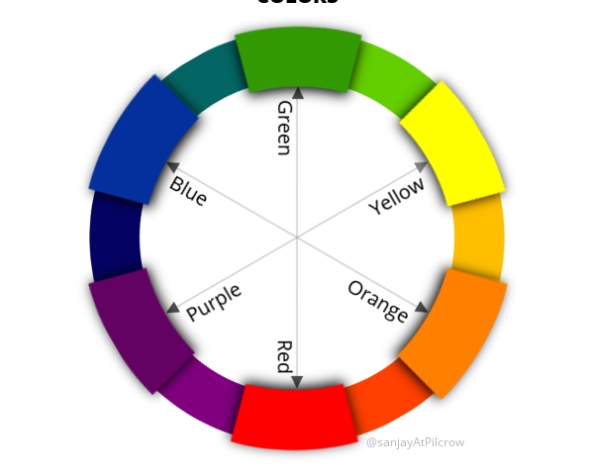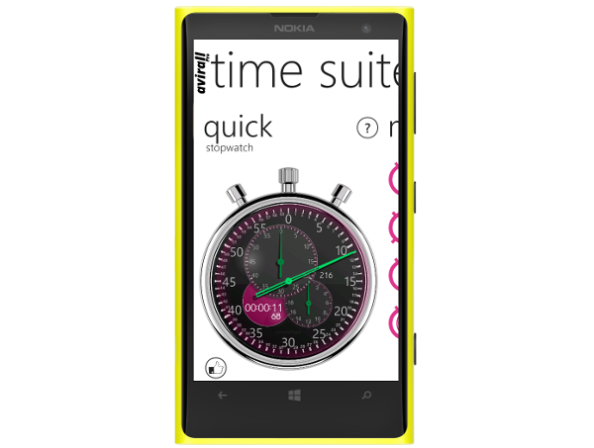
In the image above blue & orange are complementary colors, green and red are complementary colors, purple and yellow are complementary colors, etc. The formula is; two colors, placed exactly opposite to each other on color wheel are complementary. You use complementary color combination to highlight a particular item in your design. For example, if most part of your screen has blue color, for important elements on the screen you would choose orange color. Photographers and painters know about importance of complementary color in making their paintings and photographs beautiful:
In case your app design is dynamic which gives control to the user to choose a dominant color in your app, e.g. background color, you would want to know the contrast color of the chosen color on-the-fly. Particularly in Windows Phone apps, if you incorporate user selected accent color in app design, for some important elements you might need contrast color. For example, in following screenshot of my app, the accent color on the phone is magenta and the color of the hands, auto generated in code, is green.
This extension method of Color class returns the contrast color:
(HSB and RGB conversion code courtesy, Yi-Lun Luo)
namespace MyCompany.AwesomeExtensions.MediaHelpers
{
public static class ColorExtensions
{
static Random randomizer = new Random();
public static Color GetContrast(this Color source, bool preserveOpacity)
{
Color inputColor = source;
//if RGB values are close to each other by a diff less than 10%, then if RGB values are lighter side, decrease the blue by 50% (eventually it will increase in conversion below), if RBB values are on darker side, decrease yellow by about 50% (it will increase in conversion)
byte avgColorValue = (byte)((source.R + source.G + source.B) / 3);
int diff_r = Math.Abs(source.R - avgColorValue);
int diff_g = Math.Abs(source.G - avgColorValue);
int diff_b = Math.Abs(source.B - avgColorValue);
if (diff_r < 20 && diff_g < 20 && diff_b < 20) //The color is a shade of gray
{
if (avgColorValue < 123) //color is dark
{
inputColor.B = 220;
inputColor.G = 230;
inputColor.R = 50;
}
else
{
inputColor.R = 255;
inputColor.G = 255;
inputColor.B = 50;
}
}
byte sourceAlphaValue = source.A;
if (!preserveOpacity)
{
sourceAlphaValue = Math.Max(source.A, (byte)127); //We don't want contrast color to be more than 50% transparent ever.
}
RGB rgb = new RGB { R = inputColor.R, G = inputColor.G, B = inputColor.B };
HSB hsb = ConvertToHSB(_rgb);
hsb.H = hsb.H < 180 ! hsb.H + 180 : hsb.H - 180;
//hsb.B = isColorDark ? 240 : 50; //Added to create dark on light, and light on dark
rgb = ConvertToRGB(_hsb);
return new Color { A = sourceAlphaValue, R = rgb.R, G = (byte)rgb.G, B = (byte)rgb.B };
}
internal static RGB ConvertToRGB(HSB hsb)
{
// By: <a href="http://blogs.msdn.com/b/codefx/archive/2012/02/09/create-a-color-picker-for-windows-phone.aspx" title="MSDN" target="_blank">Yi-Lun Luo</a>
double chroma = hsb.S * hsb.B;
double hue2 = hsb.H / 60;
double x = chroma * (1 - Math.Abs(hue2 % 2 - 1));
double r1 = 0d;
double g1 = 0d;
double b1 = 0d;
if (hue2 >= 0 && hue2 < 1)
{
r1 = chroma;
g1 = x;
}
else if (hue2 >= 1 && hue2 < 2)
{
r1 = x;
g1 = chroma;
}
else if (hue2 >= 2 && hue2 < 3)
{
g1 = chroma;
b1 = x;
}
else if (hue2 >= 3 && hue2 < 4)
{
g1 = x;
b1 = chroma;
}
else if (hue2 >= 4 && hue2 < 5)
{
r1 = x;
b1 = chroma;
}
else if (hue2 >= 5 && hue2 <= 6)
{
r1 = chroma;
b1 = x;
}
double m = hsb.B - chroma;
return new RGB()
{
R = r1 + m,
G = g1 + m,
B = b1 + m
};
}
internal static HSB ConvertToHSB(RGB rgb)
{
// By: <a href="http://blogs.msdn.com/b/codefx/archive/2012/02/09/create-a-color-picker-for-windows-phone.aspx" title="MSDN" target="_blank">Yi-Lun Luo</a>
double r = rgb.R;
double g = rgb.G;
double b = rgb.B;
double max = Max(r, g, b);
double min = Min(r, g, b);
double chroma = max - min;
double hue2 = 0d;
if (chroma != 0)
{
if (max == r)
{
hue2 = (g - b) / chroma;
}
else if (max == g)
{
hue2 = (b - r) / chroma + 2;
}
else
{
hue2 = (r - g) / chroma + 4;
}
}
double hue = hue2 * 60;
if (hue < 0)
{
hue += 360;
}
double brightness = max;
double saturation = 0;
if (chroma != 0)
{
saturation = chroma / brightness;
}
return new HSB()
{
H = hue,
S = saturation,
B = brightness
};
}
private static double Max(double d1, double d2, double d3)
{
if (d1 > d2)
{
return Math.Max(d1, d3);
}
return Math.Max(d2, d3);
}
private static double Min(double d1, double d2, double d3)
{
if (d1 < d2)
{
return Math.Min(d1, d3);
}
return Math.Min(d2, d3);
}
internal struct RGB
{
internal double R;
internal double G;
internal double B;
}
internal struct HSB
{
internal double H;
internal double S;
internal double B;
}
}
}
Get working code from my GitHub repository (POCs).



Pingback: Dew Drop – March 12, 2014 (#1741) | Morning Dew
Cool, but it would be nice if there was an example on just how to use it, too. The “dream” usage of this would be to pick a color by selecting it and be able to call GetContrast() and have it return the “opposite” color. IOW: selecting a color on the screen would put that color into memory, call GetContrast(), and then display the contrasting color, along with its metadata (HSB and RGB vals) to boot.
I created a resource to generate the Accent Compliment Color previously.
See http://blog.mrlacey.co.uk/2013/03/using-complimentary-accent-color.html
and the updated version at http://blog.mrlacey.co.uk/2013/03/accentcomplimentbrush-v20.html
Nice and easy!
Pingback: C# Extension: Random Pastel Colors | Sharp Statements